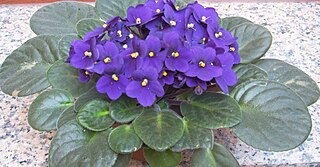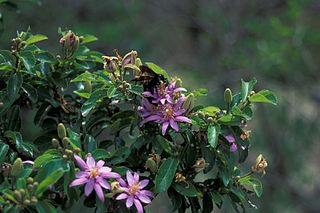
Streptocarpus sect. Saintpaulia is a section within Streptocarpus subgenus Streptocarpella consisting of about ten species of herbaceous perennial flowering plants in the family Gesneriaceae, native to Tanzania and adjacent southeastern Kenya in eastern tropical Africa. The section was previously treated as a separate genus, Saintpaulia, but molecular phylogenetic studies showed that it was nested within the genus Streptocarpus.

Acanthus is a genus of about 30 species of flowering plants in the family Acanthaceae, native to tropical and warm temperate regions, with the highest species diversity in the Mediterranean Basin and Asia. This flowering plant is nectar producing and is susceptible to predation by butterflies, such as Anartia fatima, and other nectar feeding organisms. Common names include Acanthus and Bear's breeches. The generic name derives from the Greek term ἄκανθος (akanthos) for Acanthus mollis, a plant that was commonly imitated in Corinthian capitals.

Grewia is a large flowering plant genus in the mallow family Malvaceae, in the expanded sense as proposed by the Angiosperm Phylogeny Group. Formerly, Grewia was placed in either the family Tiliaceae or the Sparrmanniaceae. However, these were both not monophyletic with respect to other Malvales - as already indicated by the uncertainties surrounding placement of Grewia and similar genera - and have thus been merged into the Malvaceae. Together with the bulk of the former Sparrmanniaceae, Grewia is in the subfamily Grewioideae and therein the tribe Grewieae, of which it is the type genus.

Dicliptera is a genus of flowering plants in the bear's breeches family, Acanthaceae. Well-known synonyms include Peristrophe and Dactylostegium.

Moritz Kurt Dinter was a German botanist and explorer in South West Africa.

Melhania is a genus of small shrubs or herbaceous plants. Traditionally included in the family Sterculiaceae, it is included in the expanded Malvaceae in the APG and most subsequent systematics. The genus is named for Mount Melhan in Yemen.

Setaria is a widespread genus of plants in the grass family. The name is derived from the Latin word seta, meaning "bristle" or "hair", which refers to the bristly spikelets.

Ampelodesmos is a genus of Mediterranean plants in the grass family, which is known by the common names stramma, Mauritania grass, rope grass, and dis(s) grass. It is classified in its own tribe Ampelodesmeae within the grass subfamily Pooideae.

Hans Schinz was a Swiss explorer and botanist who was a native of Zürich.

Hermannia is a genus of flowering plants in the mallow family, Malvaceae. It comprises at least 65 species with many more species as yet unresolved.

Petalidium, commonly known as petal-bushes, is a genus of perennial shrubs in the acanthus family. They are native to sandy flats or stony slopes in the drier bush regions of Africa, India and the Mascarene Islands. The majority of species occur in frost-free, summer rainfall regions of southern Africa, and may be found from low to medium altitudes.

Crossopetalum, commonly known as Christmas-berries or maiden berries, is a genus of flowering plants in the family Celastraceae. It comprises about 30-40 species.
Duosperma is a genus of flowering plants belonging to the family Acanthaceae.
Hermbstaedtia is a genus of flowering plants belonging to the family Amaranthaceae.
Schinziella is a monotypic genus of flowering plants belonging to the family Gentianaceae. The only species is Schinziella tetragona.
Mechowia is a genus of flowering plants belonging to the family Amaranthaceae. It is also in the Amaranthoideae subfamily.

Pterodiscus is a genus of plant in the Pedaliaceae family comprising several species with a native range from Ethiopia to S. Africa. The range passes through the countries of Angola, Botswana,, Ethiopia, Kenya, Mozambique, Namibia, Somalia, Sudan, Tanzania, Zambia and Zimbabwe. Plus it is found also within the Provinces of South Africa in Cape Provinces, Free State, KwaZulu-Natal and Northern Provinces.












